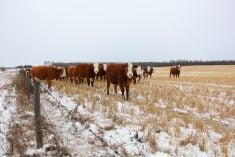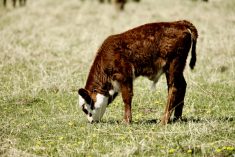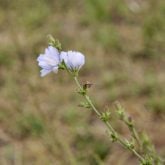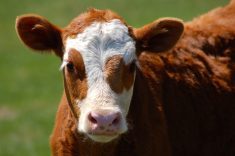With the fall 2018 anthrax outbreak in northern B.C., now is an ideal time to review prevention strategies.
In 2006 we learned lots about the disease and how to control it with the big outbreak in Western Canada. Cattle are very susceptible, along with a long list of other species including bison and horses.
It is also considered a zoonosis which means humans can contract it. Fortunately, people generally contract the cutaneous (skin) form, which responds well to antibiotics. In fact, in the last large outbreak, with hundreds of producers and veterinarians exposed to anthrax, only two contracted the skin form and were treated.
Read Also

Building demand together: The impact of Canada’s beef import levy
The beef import levy has become a central tool for ensuring balance in Canada’s beef industry
We all know cattle contact the spores from the soil and spores can remain infective for at least 250 years if buried deep. They are extremely durable. Soils high in organic material, calcium and with a lower pH favour survival. Spores on the soil surface do break down over a few years. It is these favourable soil conditions which make it easier for experts to predict where outbreaks might eventually occur.
Outbreaks occur primarily in wet springs followed by a very hot, dry summer or in very dry conditions. Very wet springs or flooding bring spores to the surface where grazing animals come into contact with them. In dry years, livestock generally will graze low areas close to the ground where they normally don’t have access. They may contact the spores. If enough spores are ingested a toxemia results in severe weakness, inco-ordination and depression followed very quickly by death.
All sudden deaths in cattle or other species should be autopsied by your herd veterinarian. Not only do the mature cattle qualify for the BSE program, finding out the cause of death in the sentinel case allows you and your neighbours to initiate a preventative program. Blood not clotting, lack of rigor mortis to the carcass and other findings such as an enlarged spleen indicate a possible anthrax diagnosis. Veterinarians will not open the carcass if previous cases have been reported.
Anthrax is still a reportable disease to the Canadian Food Inspection Agency (CFIA), but rules have been greatly changed since April 1, 2013. This was no April fool’s joke. The CFIA has dropped services such as helping with diagnosis, disposal compensation and providing disinfection expertise.
It is really now up to your local veterinarian to help in the diagnosis and follow up. The CFIA had the U.S. military quick tests on blood available for quick diagnosis and now those same tests are available through the chief provincial veterinarians and available to private veterinarians in endemic areas. The CFIA website gives good recommendations on disinfection or disposal. Anthrax was limited to Alberta through to western Ontario. It’s now also present in the Peace region of B.C. These are the areas practicing veterinarians must be ever vigilant. Your local veterinarian will know whether cases have been reported in your area and whether vaccination is advisable.
The preventative vaccine is a non-encapsulated live spore vaccine. It is called the anthrax spore vaccine (sterne 34F2 strain) and is manufactured by the Colorado serum company in the U.S. Immunity to the vaccine is almost 100 per cent protective after giving two shots three to four weeks apart. These must be boostered yearly to maintain immunity, preferably just before the prime time for contraction in the summer.
The vaccine is administered subcutaneously and slaughter withdrawal in cattle would be around 42 days. Unlike other vaccines, it’s important not to administer antibiotics at the time of vaccination. Bison are not on the label of the vaccine but it is protective. Essentially, a prescription is needed as it is off label to use it.
My recommendations would be to vaccinate if a herd of cattle was diagnosed in your immediate area, especially if on the same water course. During the 2006 Saskatchewan outbreak, Dr. Greg Douglas, a veterinarian with the CFIA, recommended vaccinating all cattle, horses, sheep, goats and bison within a five mile radius of all positive cases. This was very wise advice.
Generally speaking with cattle, vaccination for anthrax is not part of most routine preventative programs. This is simply because the incidence is very low and sporadic based on confirmed cases. Since the spores are extremely resistant, if cattle were pastured in areas with a history of anthrax, I would vaccinate indefinitely. Cost is minimal and protection is high. If there has never been a case in your immediate area, there is probably no need to vaccinate.
There have been reports of anthrax coming in on feed. This is possible when round bales are made in old lake bottoms during a drought. Dirt can get wound into the bales. If sourcing your feed from a confirmed anthrax area, this would be another good reason to vaccinate your herd.
Discuss all vaccination requirements, including anthrax, with your herd veterinarian and hopefully we can continue to keep this dreaded disease in check across Western Canada. Don’t stop vaccinating just because there have been no recent outbreaks. The reason there have been no big outbreaks, especially in light of all the flooding or droughts, is because producers are vaccinating and protecting their herds.
Be informed and do not place blame if a producer gets anthrax, as it may have been sitting dormant for well over 100 years. It will strike when conditions are right.
















